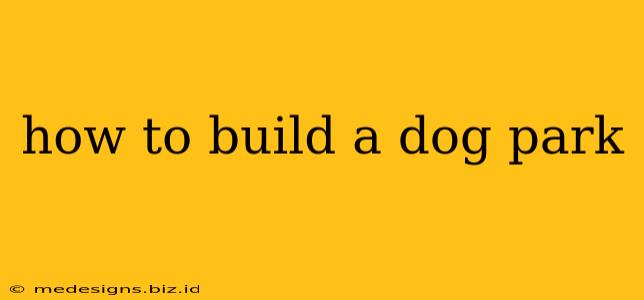Building a dog park is a rewarding project that benefits both canine companions and their owners. This comprehensive guide walks you through the process, from initial planning to grand opening. Whether you're building a small park for your neighborhood or a larger facility for your community, this guide provides the essential steps.
Phase 1: Planning and Design
Before breaking ground, meticulous planning is crucial for a successful dog park. This phase sets the foundation for a safe and enjoyable space.
1.1 Assess Your Needs and Resources:
- Identify your target audience: Consider the size and breed of dogs that will frequent the park. This influences the design and size of the enclosures.
- Location, location, location: Choose a site with good drainage, visibility, and accessibility. Consider proximity to residential areas, avoiding noise complaints.
- Budget: Determine realistic costs for land acquisition (if necessary), materials, construction, and ongoing maintenance. Explore funding options like grants or community fundraising.
- Legal considerations: Check local zoning regulations, obtain necessary permits, and understand liability issues.
1.2 Design Your Dog Park:
- Size and layout: Design a park appropriate for your anticipated user base. Consider separate areas for small and large dogs to prevent bullying.
- Fencing: Robust fencing is essential for safety. Use strong materials like chain link or welded wire, ensuring it's securely anchored and at least 6 feet high. Consider burying the bottom section to prevent digging.
- Gates: Install sturdy, double-gated entrances to prevent dogs from escaping.
- Amenities: Plan for amenities such as waste disposal stations (with bags provided), benches for owners, shade structures, water fountains (for both dogs and humans), and agility equipment (optional).
- Drainage: Good drainage is vital to prevent muddy conditions. Consider incorporating gravel pathways and ensuring proper grading.
Phase 2: Construction
With your plan finalized, it's time to bring your dog park to life. This phase demands careful execution and attention to detail.
2.1 Site Preparation:
- Clearing the land: Remove existing vegetation, debris, and any potential hazards.
- Leveling the ground: Ensure a level playing field for safety and accessibility.
- Drainage installation: Install drainage systems to handle excess water.
2.2 Fencing and Gates:
- Install fence posts: Set strong, deeply anchored posts to support the fencing.
- Install fencing: Securely attach the fencing to the posts, ensuring a tight and secure barrier.
- Install gates: Install double gates with secure latches.
2.3 Amenities Installation:
- Waste disposal stations: Install robust, conveniently located waste disposal stations.
- Benches and shade: Place benches and shade structures in strategic locations.
- Water fountains: Install water fountains for dogs and humans.
- Agility equipment (optional): Install appropriately sized and spaced agility equipment.
Phase 3: Maintenance and Ongoing Care
A well-maintained dog park enhances its longevity and ensures a safe environment. This phase is essential for long-term success.
3.1 Regular Cleaning:
- Waste removal: Regularly remove dog waste to maintain hygiene.
- Ground maintenance: Keep the ground level and clear of debris.
3.2 Fence and Equipment Inspections:
- Regular checks: Regularly inspect the fencing and equipment for damage or wear. Repair any issues promptly.
3.3 Community Engagement:
- Rules and regulations: Clearly post rules and regulations for park usage.
- Communication: Maintain clear communication with park users regarding maintenance and any issues.
Conclusion
Building a dog park is a community endeavor requiring careful planning, construction, and ongoing maintenance. By following these steps and staying committed to the project, you can create a valuable resource for dog owners and their furry friends. Remember to prioritize safety, accessibility, and community engagement throughout the entire process. The result will be a vibrant, welcoming space where dogs can play and socialize.
